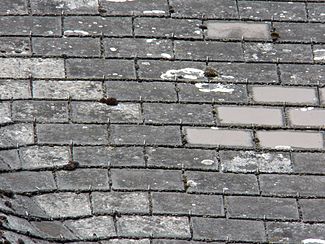Unit 5: Canada's Greatest Toxic Export
- Michias
- Jan 5, 2019
- 4 min read
Updated: Jan 22, 2019

Breathe in and out.
In and out.
Introduction
I guess it's been a while since you have thought about breathing. And it's good that we are breathing because that would indicate that the quality of air is at the perfect level to support life. On average, we inhale 17,000-30,000 times a day. And to think that some people think about their every breath, wondering if the next one will be their last. Researchers say that 92% of the global population live in places with unhealthy air quality. These people are forced to wear masks or walk around with a personal oxygen supply. Imagine if the air quality issue was not only in the environment, but in places we view as establishments of security like houses, schools, or workplaces. The sad truth is that some people suffer from this dilemma; with the cause of the problem being asbestos.
In this blog, I will go through different aspects of this naturally occurring silicate mineral commonly referred to as asbestos.

What Is Asbestos?
Asbestos is not a fabricated substance. Surprisingly, asbestos occurs naturally as a stone made up of six naturally occurring silicate minerals. These six asbestos minerals come from metamorphic rocks. More specifically serpentinite, carbonatites and some mafic rocks. Asbestos minerals are made up of long and thin fibrous bundles. A ball of thick fuzz comes to mind when describing the fiber bundles apparence. The texture of asbestos resembles dry grass. (refer to figure 1).
History of Asbestos
The first recorded use of asbestos was in 4,500 BC near Lake Juojärvi, Finland. Scientists discovered that the inhabitants near Lake Juojärvi, Finland used it to make cooking utensils like pots and pans. However, the real recognized discovery was in 300 BCE when Theophrastus, Aristotle’s student, discovered a substance that appeared to resemble “rotten wood” and had a remarkable resistance to fire even when doused with oil. It was then the word asbestos was introduced. Asbestos comes from the ancient Greek ἄσβεστος, meaning “inextinguishable”.
Asbestos physical properties
Naturally occurring fibrous minerals
Chemical resistant
Good tensile strength
Flexibility
Heat resistant
Good insulation (Electrical resistance)

Examples of the most common asbestos (Fig 1)
Chrysotile; “White Asbestos”
Amosite; “Brown Asbestos”
Crocidolite; “Blue Asbestos”
Health issue with Asbestos

Allowing the fibers of the asbestos to enter the environment and the human’s internal system can be harmful. With the asbestos present in homes, the asbestos fibers will eventually be inhaled into the lungs which can cause damage to the respiratory system. This is a chemical reaction of chrysotile, a highly common form of asbestos, and the carbon dioxide in your lungs. Mg₃Si₂O₅(OH)₄(s) + 3 CO₂(g) ⟶ 2 SiO₂(s) + 3 Mg(CO₃) + 2 H₂O(l)
Like previously mentioned, asbestos’ fibers are thin and quite long, so when the fibers are inhaled, they are placed in the alveoli. The fibers of the asbestos are recognized as a human carcinogen. The respiratory system cannot break down the fibers and that is what causes damage to the respiratory system. If the fibers travel to the membrane lining of the lungs, the asbestos can cause significant damage. When breaking down what the reactants produce, silicon dioxide in your system will increase the chances of silicosis, bronchitis, or lung cancer. The magnesium carbonate leads to stomach upset and diarrhea.
Some Places where asbestos can be found
a) in cement pipes b) in construction mastics c) in roofs
d) cooling towers e) roofing shingles f) in fire doors
Article
https://www.cbc.ca/news/canada/ottawa/new-asbestos-regulations-proposed-federal-government-2018-1.4479715
CBC’s Julie Ireton published an article in early 2018 about the discussion of enforcing the prohibition of asbestos throughout Canada. The federal government are publicly making aware that asbestos is a human carcinogen corresponding to what the World Health Organization’s International Agency for Research on Cancer declared more than 30 years ago. Catherine McKenna, the Environment and Climate Change Minister as well as Hassan Yussuff, president of the Canadian Labour Congress comment on the focus of asbestos with a sense of euphoria but want to continue to enforce this ban. McKenna and Yussuff have been both affected with the carcinogen of asbestos but, luckily with minimal damages. Kathleen Ruff, a long-time campaigner against asbestos is content with the new ban ; nevertheless, she is not fully satisfied, stating “--launch a national campaign to provide information and assistance to asbestos victims and their families,”.
Personal

Canada has been a powerhouse in the production of asbestos. With all the metamorphic rock under the ground, there's no wonder that Canada is abundant in asbestos (refer to figure 3) We even created a city in Quebec called Asbestos.

In 1950, miners in just Quebec have pulled out a minimum 900 000 metric tons of asbestos each year. By 1960, Canada produced 40% of the world’s asbestos. (Refer to figure 4). The presence of asbestos was viewed as a helpful invention of insulation in workplaces in the 1940s. However, since then, asbestos-related deaths have accounted for a third of workplace deaths. All in all, I am pleased that the federal government has taken charge on this issue. And like Kathleen Ruff said, I truly believe that we need to carry out this ban of asbestos more sternly because of its dangerous properties.
As a country, we AS-BEST-OFF without asbestos.
As stated in this article, do you really believe that most of all the asbestos will be removed from our homes, schools and/or workplaces by the end of 2019? Explain why.
Sources;
RightOnCanada. (2006-12-28). Exporting Harm: How Canada Markets Asbestos to the Developing World. Retrieved from https://rightoncanada.ca/?p=3331
Mold Busters. (2018-08-28). Canada Asbestos Guide: What Does Asbestos Look Like?
Retrieved from https://www.bustmold.com/resources/about-asbestos/
EPA. (2018-09-17). Learn About Asbestos. Retrieved from https://www.epa.gov/asbestos/learn-about-asbestos#asbestos
Mesothelioma Help Cancer Organization. (2018-07-31).Asbestos History Timeline. Retrieved from https://www.mesotheliomahelp.org/asbestos/history/
Encyclopædia Britannica. (2018-08-09). Asbestos. Retrieved from
https://www.britannica.com/science/asbestos-mineral
CO2 SEQUESTRATION. (2015-01-17). MAGNESIUM SILICATE MINERAL CARBONATION IN FINLAND. Retrieved from http://www.entek.chalmers.se/~anly/symp/01zevenhoven.pdf
Brayton Purcell LLP. (2015-05-18). Where Can Asbestos be Found in my Home?
Retrieved from https://www.asbestosnetwork.com/blog/2016/08/where-can-asbestos-be-found-in-my-home.shtml


















The concern with asbestos is as real as it is dangerous. Using the statistics you have mentioned, it is very important we do our best to carry out the ban initiative that has been put in place. However, in many countries, Canada especially, asbestos is a part of our industries. The ban proposed will, therefore, have an impact on our industries including cement pipe manufacturers and automotive businesses that import asbestos-containing parts such as brake pads. If we were to successfully carry out a ban of all asbestos, we are looking at the loss of jobs and the loss of its function. Asbestos materials have been used for insulation in buildings and in various products such as roofing materials, water supply…